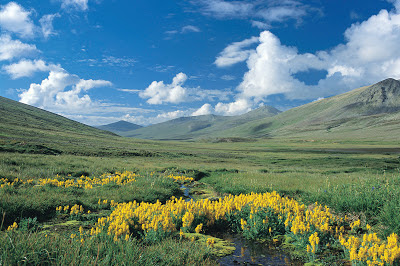Deosai: Land of the Giant
16 March 2013
Lying just 30 km south of Skardu (Baltistan) and sitting at 4000 metres (13,200 feet) above the sea, Deosai is the highest and largest plateau in Pakistan. Hemmed in by snow-draped crags a thousand metres higher still, it is a land of fens, rolling meadows, icy streams of crystal water and skies sculpted with fleecy clouds.
At this altitude there are no trees and summer is short and crisp. That is when the grass and sedge grow tall and dozens of different species of wild flowers turn Deosai into a colourful palette. That is when skylarks sing and lammergeyers quarter the cloud-laden skies for animal cadavers. Then the stoat and the Tibetan fox hunt amid the rocks, the brown bear browses in the grass and the wolf and snow leopard prowl the peaks for ibex.
By September, autumn turns the plateau brown; the birds depart for warmer climes, the animals prepare to go into hibernation and freak blizzards turn the landscape a pristine white. That is the way it remains until the following June.
The tree-less expanse of Deosai where no crops could mature because of the shortness of summer mystified the nomadic Gujjar herders who camp on Deosai to fatten their cattle during the summers. For them this vastness was the Land cultivated by the Giant: Dev Vasai from which the name Deosai derives. Their legend recounts that the dev having come upon this spacious plateau decided to settle here. He ploughed the land, planted his rice and waited for it to ripen. But even as August was only half through, his crop failed to mature.
As dawn frost became more frequent, the giant grew desperate until along came a smart little fox to mock him. ‘You silly dev, you starve here waiting for your crop to ripen while the folks of Skardu feast on their luscious apricots.’ Thus Gujjar legend has the fox speaking to the giant. ‘Summer is all but over and soon the snow will kill your rice. Be gone, if you know what is good for you; depart now and seek another home for yourself for no crop will ever grow on this land.’
Discouraged by his stunted rice fields, the dev heeded the clever fox and went off to seek his fortune elsewhere. The Gujjars preserved his venture to farm the land by calling it Dev Vasai and in their annual transhumance to the plains, carried the name to the rest of the subcontinent. There usage turned it to Deosai. To this day, the Gujjars believe that the land was cursed by the frustrated dev because it supports neither trees nor crops. In reality, at its height Deosai sits well above tree-line where summers are too short for even barley to ripen.
In Mughal India fact and fiction about this vast high altitude wilderness mingled and it was commonly beloved that north of the Kashmir Valley there stretched a plateau all the way to the deserts of Tartary. It was only in the 1830s that the British explorer Godfrey Thomas Vigne wrote about Deosai to tell the world of its true extant.
Related: Book Deosai: Land of the Giant
Related: Book Deosai: Land of the Giant
Labels: Book of Days 2009, Deosai, Deosai: Land of the Giant, Northern Pakistan, Tales Less Told
posted by Salman Rashid @ 00:00,
![]()
0 Comments:






Post a Comment